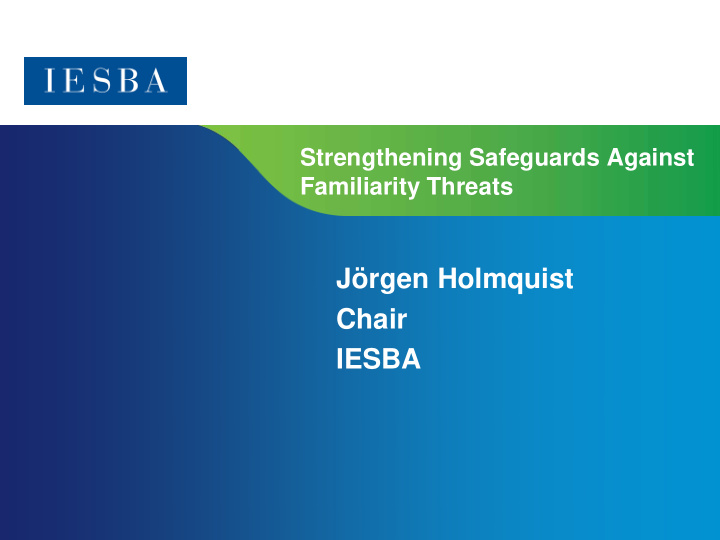



Strengthening Safeguards Against Familiarity Threats Jörgen Holmquist Chair IESBA Page 1
IESBA CAG Background • Code recognises that long-standing audit relationships can create threats to, and undermine confidence in, the independence of the auditor • Recent initiatives propose stronger safeguards: – EC Green Paper – PCAOB concept release – Various national proposals • IESBA agreed to consider whether its requirements remain appropriate Page 2
IESBA CAG EC Green Paper • Focus on independence • Concern about auditor tenure • Proposals: – Mandatory firm rotation after 6 years (9 years for joint audits); 4 year cooling-off period – Partner rotation every 7 years; 3 year cooling-off period – Would apply to PIEs Page 3
IESBA CAG PCAOB concept release • Focuses on independence, objectivity and professional skepticism • ‘Significant inherent risk’ in relationship between auditor and client • MFR suggested as one possible response Page 4
IESBA CAG IESBA Code • Long-standing audit relationships can create 2 types of threat: – Familiarity (100.12(d)) – Self-interest (100.12(a)) • Addressed through audit partner rotation • Other potential responses: – Mandatory audit firm rotation (MFR) – Mandatory firm re-tendering Page 5
IESBA CAG Code requirements: Partner rotation “In respect of an audit of a PIE, an individual shall not be a key audit partner for more than seven years. After such time, the individual shall not be a member of the engagement team or be a key audit partner for the client for two years. During that period, the individual shall not participate in the audit of the entity, provide quality control for the engagement, consult with the engagement team or the client regarding technical or industry-specific issues, transactions or events or otherwise directly influence the outcome of the engagement.” (290.151) Page 6
IESBA CAG Code requirements: Partner rotation • 2001 – maximum period of 7 years for lead engagement partner introduced for PIEs • 2005 – extended to EQCR partner • 2009 – extended to Key Audit Partners • Appropriate at that time • Now out of step? Page 7
IESBA CAG Some partner rotation requirements Term Cooling-off period IESBA code 7 2 Australia 5 2 Brazil 5 3 Canada 7 5 China 5 2 India 7 2 Japan 5 5 Russia 7 Not stated United Kingdom 5 5 United States 5 5 Page 8
IESBA CAG Partner rotation: issues • Period on engagement team • Cooling-off period • Definitions of key audit partner and other terms • Types of entity Page 9
IESBA CAG Mandatory firm rotation • Limited practical experience • Extensive academic literature –Little that directly examines the effect of MFR (see above) –Use of proxies such as restatements • Little evidence available Page 10
IESBA CAG Arguments in favor of MFR • Most effective means of strengthening “independence in appearance” • No evidence that it has damaged audit quality • New personnel would bring fresh eyes to the audit • Regular re-tendering may reduce audit fees Page 11
IESBA CAG Arguments against MFR • New firm’s lack of client knowledge may increase risk of audit failure especially large complex entities • Particular challenges for multi-jurisdictional companies • May increase costs for both company and firm • May lead to increased market concentration • May increase difficulty of recruiting/retaining specialist audit staff • May impinge on audit committee role Page 12
IESBA CAG Arguments in favor of mandatory tendering • May reduce perception of familiarity threat • Promotes judgments about balance of risk between familiarity and inexperience • May stimulate competition and innovation Page 13
IESBA CAG Arguments against mandatory tendering • May restrict auditor performance evaluation • May lead to increased market concentration • May increase costs for both firm and company • Impact on audit quality? Page 14
IESBA CAG IESBA discussion • Overarching objective of audit quality • Complex issue • Arguments finely balanced • Need to understand partner rotation requirements and MFR experiences in jurisdictions • Mandatory tendering introduced in UK • Mandatory Comprehensive Review considered in Canada Page 15
IESBA CAG Tentative Conclusions of IESBA meeting • Arguments on MFR and mandatory tendering are finely balanced • Further research and monitor developments • Review partner rotation provisions • Project Proposal on partner rotation to be prepared for December IESBA Page 16
Recommend
More recommend